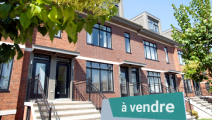Average rent for Montreal apartments in 2024
While Montreal continues to attract new residents, finding housing remains a primary concern for many individuals and families. This search often comes with a multitude of other daily living expenses and highlights the importance of understanding the average rent for apartments in Montreal.

To provide you with an overview, Centris has collaborated with Zipplex, which offers a specialized tool for observing the Canadian rental market. Their analysts conducted a comprehensive study of data from the first quarter of 2024 to present price variations and the average rent for Montreal apartments by area. The goal was to identify the underlying factors that influence prices in order to guide you in your housing decisions, whether you’re choosing your future neighbourhood or planning your budget.
Key points of Montreal’s rental market
- In the first quarter of 2024, average rent on the Island of Montreal was $1,639
- Rent was up 4.57% compared to Q4 of 2023
- Smaller apartments are more affordable
- The most affordable neighbourhoods are Montréal-Nord, Rivière-des-Prairies–Pointe-aux-Trembles, Dorval and Anjou
- The neighbourhoods with the highest average prices are Outremont, Ville-Marie and Sud-Ouest, followed closely by Plateau-Mont-Royal (5 ½)
Growth of average rent in 2024
Average rental prices by neighborhood in Montreal |
|||||||||
1 bedroom |
2 bedrooms |
3 bedrooms |
|||||||
Main neighborhoods |
Average price |
Var. |
Size |
Average price |
Var. |
Size |
Average price |
Var. |
Size |
| Ahuntsic-Cartierville | $1,170 |  |
655 | $1,597 |  |
848 | $2,020 |  |
1155 |
| Anjou | $1,224 |  |
662 | $1,491 |  |
863 | $1,710 |  |
1193 |
| Côte-des-Neiges-Notre-Dame-de-Grâce | $1,394 |  |
641 | $1,880 |  |
936 | $2,252 |  |
1142 |
| Lachine | $1,382 |  |
623 | $1,604 |  |
866 | $2,023 |  |
1088 |
| LaSalle | $1,167 |  |
643 | $1,584 |  |
922 | $1,950 |  |
1202 |
| Le Plateau-Mont-Royal | $1,512 |  |
593 | $2,028 |  |
870 | $2,576 |  |
1053 |
| Le Sud-Ouest | $1,601 |  |
641 | $2,089 |  |
882 | $2,078 |  |
1037 |
| Mercier-Hochelaga-Maisonneuve | $1,265 |  |
636 | $1,513 |  |
865 | $1,821 |  |
1132 |
| Montréal-Nord | $1,066 |  |
586 | $1,290 |  |
888 | $1,799 |  |
1164 |
| Outremont | $1,747 |  |
632 | $2,079 |  |
900 | $2,550 |  |
1101 |
| Pierrefonds-Roxboro | $1,327 |  |
617 | $1,744 |  |
942 | $1,696 |  |
1150 |
| Rivière-des-Prairies-Pointe-aux-Trembles | $1,080 |  |
731 | $1,336 |  |
900 | $1,699 |  |
1079 |
| Rosemont-La Petite-Patrie | $1,332 |  |
636 | $1,822 |  |
877 | $2,100 |  |
1107 |
| Saint-Laurent | $1,392 |  |
661 | $1,705 |  |
837 | $2,130 |  |
1034 |
| Saint-Léonard | $1,202 |  |
598 | $1,462 |  |
940 | $1,852 |  |
1187 |
| Verdun | $1,449 |  |
639 | $1,602 |  |
846 | $1,999 |  |
1023 |
| Ville-Marie | $1,629 |  |
605 | $2,218 |  |
940 | $2,673 |  |
1221 |
| Villeray-Saint-Michel-Parc-Extension | $1,199 |  |
624 | $1,548 |  |
835 | $2,021 |  |
1090 |
| Baie-d'Urfé | - | - | - | - | - | - | - | - | |
| Beaconsfield | - | - | - | - | - | - | - | - | |
| Côte-Saint-Luc | $1,767 |  |
734 | $2,546 |  |
1116 | $3,211 |  |
1309 |
| Dollard-des-Ormeaux | $1,236 |  |
567 | $1,925 |  |
896 | - | - | - |
| Dorval | $1,112 |  |
645 | $1,441 |  |
911 | - | - | - |
| Hampstead | $1,527 |  |
597 | $1,850 |  |
763 | - | - | - |
| Kirkland | $2,225 |  |
700 | $2,558 |  |
940 | - | - | - |
| Montréal-Est | - | - | $1,644 |  |
1060 | - | - | - | |
| Montréal-Ouest | - | - | - | - | - | - | - | - | |
| Mont-Royal | $1,784 |  |
800 | $2,018 | - | 1001 | $2,824 |  |
1162 |
| Pointe-Claire | $1,626 |  |
689 | $2,254 |  |
1000 | $2,423 |  |
1306 |
| Sainte-Anne-de-Bellevue | - | - | - | - | - | - | - | - | |
| Senneville | - | - | - | - | - | - | - | - | |
| Westmount | $1,601 |  |
637 | $2,618 |  |
958 | $2,980 |  |
1227 |
The average rent in Montreal has increased for the 10th consecutive quarter (since the COVID-19 lockdowns). The average rent for the period between January 1 and March 31, 2024, was $1,639, representing a 4.57% increase compared to the fourth quarter of 2023 and a 17.85% increase compared to the same period last year.
This increase was greater for three-bedroom units (5.3%) and more moderate for one-bedroom units (0.84%). The average prices for units added to the market were $1,423, $1,803 and $2,143 for one-, two- and three-bedroom apartments respectively.
The statistics and analyses conducted by Zipplex have also unveiled price differences between housing types. Imagine one tenant is living in a one-bedroom unit and another is living in a two-bedroom unit. If both tenants want to move to a unit with an extra bedroom, the first tenant will end up paying a higher additional cost than the second.
The average rent for one-bedroom units is not increasing at the same rate as for two-bedroom units, which indicates that smaller apartments are more affordable.
The most affordable and most inaccessible neighbourhoods
Montréal-Nord, Rivière-des-Prairies–Pointe-aux-Trembles, Dorval and Anjou are at the top of the list in terms of affordability on the Island of Montreal. LaSalle (3 ½) and Saint-Léonard (4 ½) are also among the cheapest considering the rental asking price for similar apartments that are available on the market.
In contrast, rent is most expensive in Outremont, Ville-Marie and Sud-Ouest, followed closely by Plateau-Mont-Royal (5 ½).
Underlying factors for geographical differences in average prices
What makes Montréal-Nord more affordable than another areas like Ville-Marie is mainly housing conditions (size, age and building characteristics) and jobs in the area. However, just because one area is more affordable, it doesn’t necessarily mean it is of lower quality.
The island’s reliable public transit network greatly facilitates travel and thus provides accessibility to areas outside of the central business districts.
Looking ahead: the importance of adding units to the market to increase access to housing
| “ | It’s important to remember that the rental market is just a sample of the total housing stock. |
| Steven Gingras, Analyst, Zipplex |
Steven Gingras highlights a key concept about rent. The level of availability only represents a fraction of the total housing stock. It is crucial to recognize that all housing available on the market varies from year to year and is significantly influenced by migration dynamics and new constructions.
New constructions tend to create what is called a spillover effect. Immigrant households aside, when an apartment becomes vacant or enters the market, another apartment becomes available as a tenant transitions from their current home to a new one. The new available apartment may lead to another tenant vacating, and so on. This sequence of moves illustrates the spillover effect.
While this effect is plausible in theory, in reality, there are a number of obstacles and limitations. Creating housing is one such factor, since a lack of new housing puts considerable pressure on the existing stock to accommodate both moves within the area and the arrival of new households. This pressure translates into a large demand for the same available housing and discourages many in their search for a new home.
For this reason, the turnover rate (i.e., the percentage of tenants who leave a property during a specific time period) is declining in Quebec. When faced with the difficulty of renting an apartment, a household with a desire or need to move could choose to stay where they are. This is why housing construction is so important.
Studying past examples
To demonstrate the impact of greater housing availability on the market, just look at the period between July 1, 2020, and June 30, 2021. During this one-year interval, Montreal experienced a more pronounced population slowdown than in previous years due to the pandemic. The population of Quebec only grew by 5,115 people in a year due to a halt on immigration.
While the context is admittedly different from today’s, it’s interesting nonetheless to examine indicators in the market. During these four quarters, housing availability in Montreal soared, as did housing starts and completions. When the population size stagnated, average rent remained stable. In the second quarter of 2020, the average rent was $1,194. A year later, it was $1,192.
This is a good example of the spillover effect and its impact on rent. There are, of course, other factors that need to be considered in this type of analysis, but this example demonstrates how adding housing can benefit the market.
Is Montreal’s trend of rising prices an isolated case?
This article focuses on Montreal, but the situation is similar for the rest of Quebec. Between the first quarters of 2023 and 2024, the average rent jumped 19.6% to $1,328, a difference of $311 in Montreal. However, the gap has since widened as other municipalities in the province appeared to catch up with Montreal between January, 2020, and March 31, 2022. In the first quarter of 2022, the rest of Quebec was $238 behind Montreal.
Improvements to public transit, in particular with the REM, will certainly increase mobility for households wishing to settle in the outskirts of Montreal, but the current problems are more likely to affect the city itself. Adding new housing is key to reducing the pressure of increasing prices, especially given the 6% drop in housing starts in the first quarter of 2024 compared to last year. It will take a little longer before there is an upturn in the Montreal CMA.
Finding an apartment based on your needs
The comprehensive analysis of Montreal’s rental market reveals a diverse landscape in terms of average prices, growth trends and affordability of neighbourhoods. While some neighborhoods offer more accessible options for tenants, others have higher costs that may be more restrictive. People searching for an apartment should take these price variations into account and find a balance between their personal preferences, budget and desired location.
Whether you're looking for apartments, condos or houses for rent, find your ideal rental property today at Centris.ca.
Note on the study methodology
To compile the statistics presented above, Zipplex analyzed the entire stock of available housing over the time periods used in this article. Only the average rental offer was considered, meaning that new constructions and rental condos were excluded from the analysis. Extreme values were also removed from the study, within a 90% confidence interval. Zipplex did not present values for areas where data was missing or results were deemed unreliable.
About Zipplex
Zipplex is an innovative and powerful tool designed to help you quickly find available rentals in your area. This unique platform improves your decision-making and allows you to keep an eye on everything to do with rental property in your area. The Zipplex offer is distinguished by two services: the analysis tool and the CTRL consulting firm.
See also:
Joint tenancy: benefits, obligations and lease
Rent-to-own: an answer to home ownership?
What is the percentage of the 2023 rent increase?
 The Largest Number of Homes for Sale
The Largest Number of Homes for Sale




